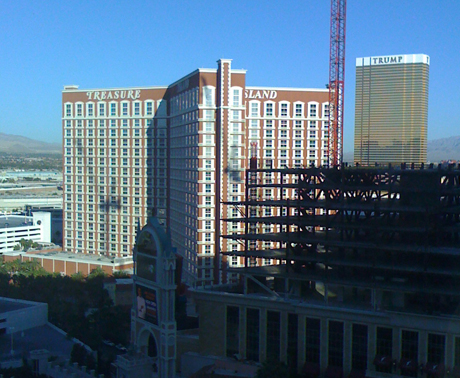
Look at the windows on Treasure Island. See the shutters? See the little balcony thingies? Now count the stories. You should come up with something close to 17.
Next let’s look at how many rooms are on a each floor. The building consists of three slabs that meet in the middle. You can see one full wall of one slab in the picture, and you can clearly see that there are 9 windows.
There are two problems here. Treasure Island is a 33-story building, and the slabs are 18 rooms long.
The secret of Treasure Island is that each of those windows that appear to be a single window is actually the windows of four hotel rooms made to look like one. (Bellagio does the same thing.)
The obvious question is: Why? No secret there. It’s The Strip. It was done to make money. Which takes us to the next question: How does this optical illusion generate more profit than the alternative?
You’re on your own on that one. All I promised was a secret. I didn’t say anything about solving mysteries.

10 Comments
I have multiple ideas, it’s possible any or all of them play a contributing part.
Customer perception of room views. Potential customers looking at TI see the large windows and imagine if they stay there their room must have one of these large windows which would be really nice. The perception is subtle enough they don’t notice when it’s disappointed, besides they’ve already checked in by that point.
Customer perception of room height. If the desk says I can have a room on the 16th floor I think that’s practically a penthouse.
Fewer holes in the wall. Less expensive to build, and can be bigger while taking less of a hit to structural integrity.
Or maybe they just like that facade design and it had to be way bigger than the room windows to work.
Good luck in Vegas.
The answer to your question lies in a side-by-side comparison of Treasure Island and Monte Carlo, which opted for the “Prison Barracks” motif.
Cheers,
Doug
Wow Damien. You’re good at this.
Potemkin Village… both saving money on window holes and giving impression of spaciousness.
New Caesars additions and Palazzo are very Stalinistic – paint them gray and you have Party headquarters in downtown Moscow.
Great observation and analysis.
Note how the Trump bldg gives an example of using mirrored windows, rendering your room size/qty estimating techniques ineffective. Information hiding instead of outright deception.
I’d say they’re creating the illusion of the colonial era, which is really hard to do in a genuine high-rise. By effectively doubling the scale of the windows, they are aiming to achieve their illusion, representing some sort of dock-side structure, while also giving the impression that the building is smaller, cozier, and homier than it really is.
It’s a good catch! I’m not sure I would have noticed this illusion!
Simple answer. It makes the building look more proportional.
As Tommy said, the Bellagio does the same thing. Add to it the Augustus tower at Caesar’s.
Almost nobody notices, but everybody thinks it’s cool when it’s pointed out.
As has been said before, the house always wins. Very sneaky!
Hey Tommy…Paul and I were with you at this time. I remember you pointing it out to us when we went for our mindful walk to the Mirage… happy memories :))
Hi Jan! Happy memories indeed!
Add Comment